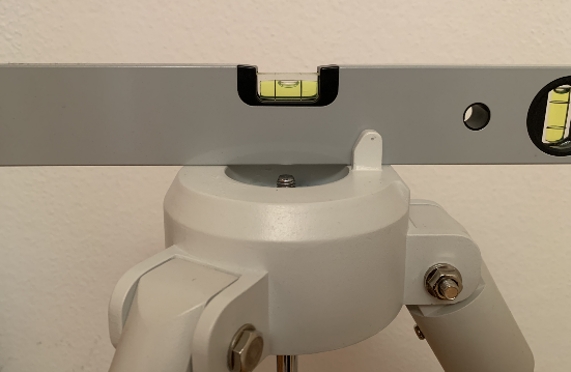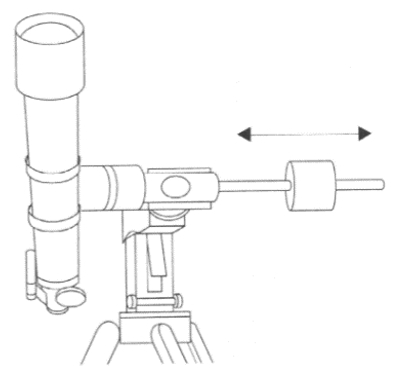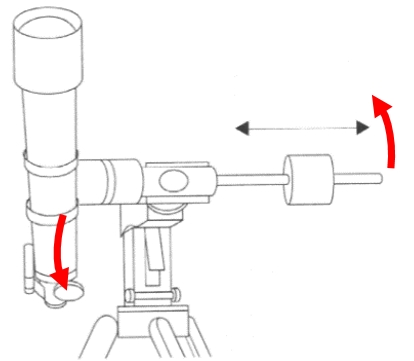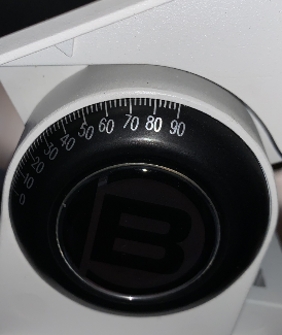Setting up and wiring the telescope
Aligning the mount of a telescope toward the geographic North Pole should be done as accurately as possible. The better this alignment is accomplished, the fewer difficulties there will be during photography. The first step of the alignment is to position the tripod and the mount so that the right ascension axis (see menu item 'Components' - 'Mount and tripod') can be aligned parallel to the Earth's axis.

Possible observation position with representation of the angles (Picture Earth: NASA, Public domain, via Wikimedia Commons)
The following steps must be performed:
| Step | Description | Illustration |
| (1) | - Set up the tripod so that the azimuth adjustment pin and the aligned support leg point in the North-South direction.
- The azimuth pin is on the north side. (Note: Manufacturers vary on which side of the azimuth pin the support leg is located).
- It is helpful to use a compass or a compass app for smartphones
- In the smartphone settings, select to display the geographic North Pole rather than the magnetic North Pole.
- Align the other two legs of the tripod with the East-West line.
| 
Tripod with azimuth pin on tripod leg side [1]
Tripod with azimuth pin on other side [3]
|
| (2) | - Align the support surface of the mount as horizontally as possible (use circular level or spirit level) → For the later alignment of the right ascension axis parallel to the Earth's rotation axis, the horizontal setup must be done well, but not absolutely precisely. However, a result as precise as possible simplifies the later steps. (Remark: If it is intended to shorten the aligning with the "Scheiner-method" by a very good polar altitude alignment using a digital spirit level (see menu point 'Basics' - 'Theoretical basics for "Scheiner-method"'), the tripod should be aligned as precisely as possible).
| 
Horizontal alignment of the tripod in North-South direction
Horizontal alignment of the tripod in East-West direction
|
| (3) | - Placing the mount on the tripod base
- The horizontal alignment can be checked again via an attached circular level.
|  Attached mount with circular level for checking the inclination |
| (4a) | - To balance the right ascension axis, mount the tube with all attachments on the rail.
- Bring the counterweight rod and the tube into the horizontal position.
- Move the counterweight so that the tube and the counterweight are approximately in balance (hold both sides firmly so that the tube or the counterweight do not bump against the stand).
|  Balancing the right ascension axis [2] |
| (4b) | - To reduce the play of the spindle in the motor somewhat when tracking the star movement, the counterweight should be adjusted so that the tube including accessories pulls down slightly more than the counterweight. The tube should always tighten the counterweight a little. If it is not tightened (i.e. if the system is too well balanced), there will be a slight "wobble" (due to slight play when tapping on the spindle) during tracking, which will have a negative effect on the results for long exposures.
| 
Adjusting the counterweight to reduce the backlash during tracking [2] |
| (5) | - To balance the declination axis, leave the counterweight rod and the tube in the horizontal position.
- Move the tube in the holding rail until it no longer tilts up or down and remains horizontal.
|  Balancing the declination axis [2] |
| (6) | - Set the pole height using the scale (e.g. 48°).
- Since the scale is not very accurate, an improvement can be achieved by using a smartphone spirit level with degrees, a protractor or a digital clinometer.
|  Polar altitude scale to display the latitude |
| (7) | - If the tube is then aligned with the index marks of the mount, a position is reached which is defined by the telescope as the home position. From this position, the internal coordinate system is set and the alignment is started.
- After an observation phase, this position can easily be approached again.
|  Index markings of a mount [1] |
Sources:
[1] https://nimax-img.de/Produktdownloads/59579_1_Anleitung_DE.pdf
[2] https://www.fernrohrland-online.de/uploadedfiles/EQ5-Anleitung.pdf
[3] https://www.teleskop-express.de/shop/product_info.php
After everything is set up, the components can be wired. In the following, this is demonstrated on a Schmidt-Cassegrain.


In order for the PC to communicate with the mount and the camera at all, ASCOM drivers are required, which run over an ASCOM platform. The ASCOM drivers are either offered for download on the manufacturer's pages or can be downloaded directly from the ASCOM website.












